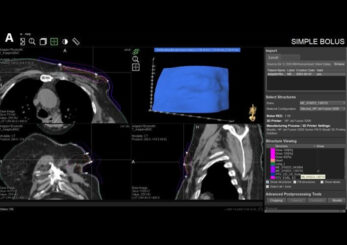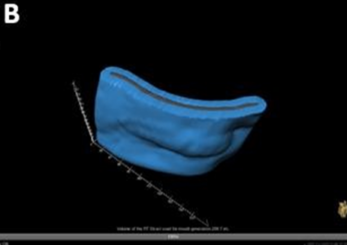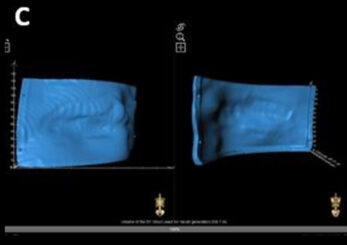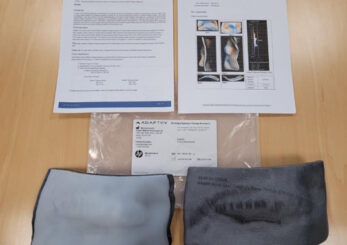
Adaptiiv On Demand TrueFlex Modulated Electron Bolus for a Chest Wall Boost
Dana-Farber Cancer Institute Patient Case Study
Overview
Adaptiiv Medical Technologies Inc. (Adaptiiv) provides cancer centers with regulatory cleared software to design and 3D print patient-specific radiotherapy accessories.
The following case demonstrates the conformality of Adaptiiv On Demand (AOD) TrueFlex Bolus to irregular post-mastectomy chest wall anatomy, facilitating treatment setup and minimizing air gaps. TrueFlex Bolus is also soft to the touch, increasing patient comfort. Adaptiiv’s Modulated Electron Bolus (MEB) solution which optimizes the bolus thickness to improve treatment plan quality and increase the clinical precision and accuracy of dose delivery for the sequential electron boost portion of post-mastectomy chest wall treatment.
Patient History & Description
The patient was referred for left chest wall and regional lymph node post-mastectomy radiotherapy using 3DCRT. Conformal photons were delivered to the chest wall and regional lymph nodes, 50 Gy over 25 fractions, followed by a sequential mastectomy scar electron boost of 10 Gy over 5 fractions. A uniform 5 mm virtual bolus was initially planned; however, irregular surface geometry resulted in higher than typical hot spots. There was also concern about a poor bolus fit and increased setup time. Given these reasons, a TrueFlex MEB was requested. The electron boost field was directly incident to the bolus (chest wall surface) using an A15 aperture.
Design & Fabrication
A patient specific MEB was designed in 3DBolus covering the chest wall encompassing the scar. The initial 5 mm uniform thickness bolus was created using a custom target structure created by the Boolean overlap between a 2 cm outer margin of the scar and a 5 mm expansion of the BODY structure. This custom target structure was created to ensure sufficient lateral coverage. The dose from a 9 MeV electron beam was calculated on the initial bolus, using a volume normalization of 90% prescribed dose to 100% volume of the custom target structure. The bolus thickness was modulated using Adaptiiv software to ensure the 90% prescription isodose was conformal to the custom target structure.

Figure 1: (A) The 3D Bolus software displaying the DICOM CT Data and RT Structure Set with the selected bolus structure rendered in blue.

Figure 2: Figure 1, cont. (B) the TrueFlex two-piece mould shown in blue, and the bolus material shown in translucent grey.

Figure 3: Figure 1, cont. (C) the separated pieces of the mould showing the alignment guides to ensure the two pieces are put together accurately.
After finalizing the MEB design via dose calculation in the TPS, the design was submitted as a mould using the Adaptiiv On Demand (AOD) service. The mould design was automatically sent to Adaptiiv’s manufacturer HP, which uses Multi Jet Fusion technology to print the mould using a rigid PA12 material. The mould is filled using EcoFlex 00-30 silicone to produce the TrueFlex bolus. TrueFlex bolus are soft to the touch and highly flexible, making it ideal for patient comfort while ensuring conformality to a large surface coverage. The AOD service performed quality assurance ensuring the TrueFlex bolus physical density and spatial fidelity were within the specified tolerances.

Figure 4: The initial trajectory setup for the applicator. The inter-trajectory distance was 10 mm, with the inter-slice distance enforced.
Results
The patient tolerated the treatment quite well. By the end of treatment, she did have expected toxicities including moist desquamation in the supraclavicular portion of the treatment field and moderate hyperpigmentation throughout.
The radiation therapists felt the custom bolus conformed quite well to her chest wall surface resulting in efficient and reproducible setup.
Summary
- Adaptiiv’s TrueFlex Modulated Electron Bolus (MEB) offered a soft and flexible solution providing an excellent fit on the patient, while also tailoring the prescription isodose to the target volume.
- The patient tolerated the breast boost well, and the RTs found the TrueFlex MEB conformed to the patient’s anatomy and provided a reproducible setup.